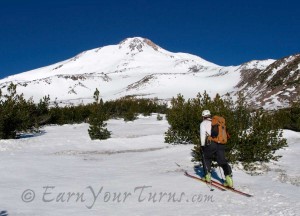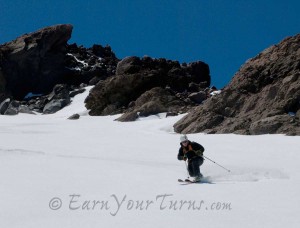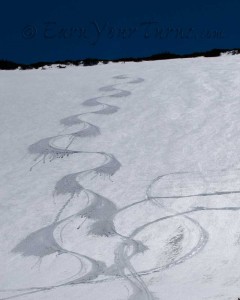I was finally able to demo the TTS binding on a recent ski trip to Mt. Shasta in June. Craig kindly set me up with the system (utilizing La Sportiva’s RT Tech toe pieces) mounted on 177 La Sportiva GT skis (123/89/111, R=22M, 6lb/pair). I don’t know what the weight was for the binding and skis together, but it felt very airy for a mid-fat setup, especially so when paired with my Scarpa F1 bellowed AT boots.

The Telemark Tech System v2 w/ La Sportiva RT Tech Toe, G3 springs.
The heel lever, climbing post, cable bar and posts are TTS unique.
It took just a few strides for me to become fully enamored with the uphill capabilities of the binding system. Having never used Dynafits before, I was instantly smitten. I have been using free-pivoting telemark bindings for many years now for nearly all my backcountry tours (aside from those taken on low, light boots and 3-pins). I know well the benefits of resistance-free boot rotation for climbing. Somehow this system was different, and better. For reference, I typically tour on Scarpa T1s and Voile Switchbacks, and I have also logged many miles in Scarpa T2X and Garmont SynerG boots.
The TTS/GT/F1 system I tried out was very light, but I think there were some other key factors at play that made it tour so well. Boot compatibility is one of those. TTS opens up the possibility of making tele turns in bellowed boots with tech fittings like F1s, F3s (unfortunately now discontinued), or any of the NTN boots with tech fittings. Some of the TTS-compatible boot choices, in addition to being relatively light, also have superior cuff range of motion for touring compared to 75mm boot offerings. Being able to tap into a hopefully growing selection of tech-fitted light boots with smooth cuff rotation is one of the unique benefits of TTS. I also like the location of the touring pivot point with the TTS. It is further back with respect to your foot than the pivots on either the Switchbacks or Silvretta Telemark Adapters that I am more accustomed to. For me this translated into a more natural, efficient, and faster stride, again something Dynafit users have known first hand for years.
If TTS has significant negative traits with respect to climbing, I did not find any. At times I would have liked a taller climbing wire than the one on my demo setup, but it looks like the manufacturer now offers a dual climbing post heel riser. (Editors note: The taller climbing wire was not installed as I am an avowed proponent of low angle skin tracks, and low or no climbing posts 😉 )
I was quick to form a positive impression of TTS for climbing, but I think I will need some more days spent in various snow conditions to adequately assess the downhill chops of the system. My initial impressions regarding the down are favorable, however. The snow our party encountered the day I tried the system out varied from a very challenging & unpredictable semi-breakable crust to great corn to wet slop.
In the challenging crusty snow I used parallel turns. I tried to smoothly drop a knee or two in the crusty stuff, but in the end just gave up on that and ripped P-turns instead. It seemed to me that TTS has more of an “all or nothing” feel with respect to dropping the knee than 75mm gear has, at least the 75mm gear that I am used to. I surmise that this may be due to rapid spring engagement of TTS when you lift your heel, even on the least active setting. There is little vertical play or slop in the system, so it pays to commit to your tele turn early, and if you don’t you may get spanked. When you lift your heel the ski tip gets driven accordingly and quickly, for better or if you’re not prepared, for worse.
Laterally, The TTS binding is precise and powerful, with great edging. I did not notice any side to side slop. The ski feels well connected to the binding and boot. Though I did revert to parallel turns more than I wanted to at times, the system pulled them off powerfully. With some time to adjust muscle memory to TTS, I think tele turns would come more naturally in all conditions.
Once we got lower on Shasta and the firm crust yielded to softer corn, I was able to take tele turns much more easily (of course). With the give of softer snow, the spring progression felt similar to the 75mm norm tele bindings I am more accustomed to.
I am fully sold on the uphill capabilities of TTS after just one demo. From what I gleaned of my short time on them, they seem like strong downhill performers as well. If the TTS proves to be durable in the long run, I think it will be the go-to binding choice for many tele skiers across both the backcountry and resort spectrums. For big days with lots of climbing and challenging descents, it sure seems to me like the best binding out there for tele skiers right now.
© 2012




9 comments
1 ping
Skip to comment form
Nice review by B who obviously knows a thing or two about the telemark faith and has me thinking about a “big change” and the loss of the (gulp)…duckbill. Hopefully someone will pick up this binding and put some $$$ in to it followed by production. I would love to tele in AT boots! What I like about the binding is it’s being slowly developed versus the rush to market of the NTN a few years ago.
I still think a heel lock down option for doing alpine style on any telemark binding would be fantastic.
B: How do you feel the Scarpa F1 is for doing Tele turns? I tried on a pair of F1’s as I was interested in them for the same reason that you seem to like them, light weight and good ankle flexibility and range of motion, but I was surprised by how stiff the bellows seemed to be, at least on a new F1. The new F1 bellows felt way too stiff to do Tele turns for me, way stiffer than any of the 3 NTN boots I’ve skied in, Scarpa TX, TX Pro, and Garmont Prophet, and they felt considerably stiffer than a brand new pair of TX Comps that I passed on as being to stiff.
Did you find the F1 bellows to your liking? Were they well used broken in boots? If they are a broken in pair did the bellows soften up any and is there a Tele boot that you could compare the flex to? Could some of the problems you had doing Tele turns on this setup be from the F1 boots having to stiff a flex at the bellows?
I think I’ve seen this mentioned before in regards to this type of setup, but it seems like the major disadvantage would be when touring in deep snow and having snow build-up around the heel cable when it’s down around the heel block. I’ve experienced this with my 3-pin hardwires.
I’ll defer to B for most of your Qs, but do know from skiing with him that bellows flex was not an issue. Mark Lengel, developer of TTS had the same concerns initially. His experience was that it took a few days for them to soften up a bit, but they did, and he really likes their flex now. 2nd hand opinion FWIW.
Author
My F1 boots were used (lightly to moderately) when I bought them earlier this year, so the bellows had already been through enough load cycles to soften them up a bit. I can’t say that I’ve ever noticed them being too inflexible for my liking. I would say that F1 boots perform tele turns about as well as you would expect for a boot that is so light. I have used them, with success, to drive skis up to 110 in the waist (Icelantic Shamans w/Voile VP-II plate bindings). I see the relatively low cuff height, overall boot stiffness, and awkward cuff locking mechanism as being the attributes with more negative impact on downhill performance than anything related to bellows flex.
Next time I use my F1s (this weekend on Shasta again), I am going to try and dial in the adjustment of the cuff angle, which is set by screws at the rear of the cuff. I think it has been set too far forward for my liking since I got them.
Just got around to looking at this, Thanks. That is close to what is needed. Still a bit “over” mechanical. It would be nice is it was simpler and more “tech” like AT. Perhaps a dyna-fit heel assembly mixed with a 01. That would require some engineering on the boot heel.
F1 stiff? That’s kinda hard for me to believe, esp after trying on a used pair at a shop in SLC. They were well worn, but not too beat, I tried them in my TTS axls and they completely folded at the bellows, crushing my toes. Granted, they are super lightweight and my binding are much burlier than Mark’s TTS, but still the bellows are not meant for the kind of dynamic loading that comes from a telemark turn, they are dedsigned to add flexibility to a walking/hiking stride. I ski some heavilly modifed TX first generation that have been dremeled under the midfoot to improve flex and I notched the walk mode holes into one long groove, all of which really improved tourability while maintaining skiability. My TX are on par with an F3, which unfortunately is no longer being produced. If I were in the market for a lightweight TTS boot, I’d get some used current generation TX and dremel away until the flex and weight fit the bill. I’m looking toward the Crispi boots for 2013-2014, esp the Shiver Rando, as my downhill oriented boot.
The word from Alpina USA is that they have dropped Crispi from their line up, so they did not order any Rando tech fitting boots this year, all they have is last year’s old stock. No one at Alpina would say if another US distributor had been selected, which likely means that no one is getting Rando boots in the USA this year without a special order from another distributor…bummer again.
If you love making Tele turns on steep and deep terrain, if you love burying your knee and getting down in dirty when you need to, or want to, if you love the feel of the snow under you as you gracefully link “true” Tele turns with efficiency and flow, you may not appreciate these bindings very much.
If you are a skier who wants a light weight binding that tours wonderfully with an AT boot (that you can use with and Alpine set up as well) that allows you to ski down hill with a limited free heel to make a “new school Tele turn” with a more upright stance , then these may work for you.
I skied the 177 La Sportiva GT skis that are in the pic above with last years TX. I am 5’6″ weigh 140 lbs so this system seemed way too built up for me. I was very happy to get back into my old Blue T2’s and Targa G3 bindings.
[…] in a tech binding? Yes, I used the La Sportiva toe as the front half of a Telemark Tech Systembinding. Pinheads never follow the rules and the main piece of info locked heelers can glean from […]